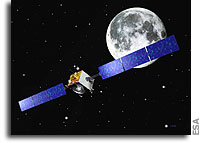SMART-1 is working well and continues thrusting

Overall status, current activities and planned activities
The spacecraft is now in its 120th orbit and has continued to function very
well. As in previous weeks, the spacecraft was operated in electric
propulsion mode almost continuously – only interupted during eclipse
periods.
From the beginning of this week, however, eclipse periods are no
longer experienced and we can now maintain constant thrust. Although we have
substantially increased the perigee SMART-1 is still crossing the radiation
belts. It has been decided, therefore, to keep the no-thrust limit of 10 000 km
to
avoid possible problems caused by the ongoing high radiation environment. As a
matter of fact, the solar activity is still quite high: two energetic solar
flares on 18
November produced a cloud of ionised gas that impacted Earth on 20 November
producing a severe geomagnetic storm that lasted for about twenty-four hours.
Despite this environment, however, SMART-1 has managed to pass through
unharmed.
The total cumulated thrust time is now more than 760 hours and we have
consumed about 12.5 kg of Xenon fuel. The electric propulsion engine
performance,
periodically monitored by means of the telemetry data transmitted by the
spacecraft and by radio-tracking by the ground stations, has shown in the last
period a slight reduction with respect to previous over performance in thrust
and
is now at about +1.3%. This is due to early adjustments to the working
conditions
of the engine. In this period a series of tests were performed on the engine
with
excellent results. The redundant cathode B has been commissioned and proved to
be functioning very well. Its performance was identical to the operational
cathode
A, which has been functioning for more than 700 hours and shows no degradation.
A new procedure to immediate ignite at full thrust has also been validated. We
have made ground tests to establish the cause of the earlier flame-out events.
The cause of the problem has been identified in an electronic component which,
under the effect of a single event upset caused by radiation, erroneously sets
the
voltage reference to zero – hence triggering the flame-out detection. We have
now prepared a procedure to automatically detect these events and restart the
engine autonomously.
The electrical power produced by the solar arrays continues to be affected, as
expected, by the radiation environment. We are now analysing, in more detail,
this behaviour by taking into account the fact that the solar irradiance is
slightly
higher now, due to Earth perihelion on 3 January, compared with launch.
According
to the latest SOHO measurement there has been an increase in the solar
constant by about 2.7% over this period. The solar arrays have reduced their
power output, due to radiation degradation, by about 82 W from the initial 1850
W
(a fall of ~4.6%). From a preliminary analysis, it seems that roughly 1% of the
degradation can be attributed to the recent solar flare events. Taking into
account
the increase in solar irradiance, the net loss is about 7.3% in 60 days or 0.12%
per
day. This degradation should last until the trajectory crosses the radiation
belts, roughly mid-to-end of December. At this rate the solar arrays will have
lost about 130 W at the exit of the radiation belts; after that the degradation
should be minor. Due to the built in power margins this will allow the
spacecraft
to continue thrusting at full power and shorten the time envisaged to reach the
Moon. A more detailed analysis on the power degradation is currently being
performed and more results will follow shortly. Stay tuned.
The communication, data handling and on-board software subsystems have been
performing very well in this period.
The thermal subsystem also continues to perform well and all temperatures are
as expected. The only item still of concern is the optical head temperature on
one
of the star tracker’s, which is too high (~17 °C) during parts of the orbit. The
momentary loss of attitude determinations has been, as previously, up to 300
times per day for an average time of only one second. There are no negative
consequences arising from this problem. There is another star tracker, which
provides good attitude determination, and the system is anyway capable of coping
with much longer periods without both star trackers. The thermal engineers have
now envisaged ways of partially reducing the temperature of the star tracker
optical heads. More on this in the next report.
Orbital/Trajectory information
The SMART-1 orbit is continuously modified by the effects of the electric
propulsion low thrust. The osculating orbital elements are periodically computed
by the ESOC specialists. These elements define the so called osculating orbit
which would be travelled by the spacecraft if at that instant all perturbations,
including EP thrust, would cease. So it is an image of the situation at that
epoch.
In reality the path travelled by the spacecraft is a continuous spiral leading
from
one orbit to another. The most recent osculating elements are as follows:
EPOCH (UTC) 2003/11/24 05:50:07.6
- Elements WRT Earth (J2000)
- Pericentre Distance (km) 11790.401694
- Apocentre Distance (km) 47699.033805
- Semi Major Axis (km) 29744.717749
- Eccentricity 0.603614
- Inclination (deg) 6.837486
- Asc. Node (deg) 154.885580
- Arg. of Pericentre (deg) 204.387331
- True Anomaly (deg) 180.031927
- Osc. Orbital Period (h) 14.181536
In this diagram the GTO, the osculating orbits at launch and at
different times are plotted. The large orbit, marked ‘final’, is the one we
expect to achieve at the end of the radiation belt escape in about one
month.
From the start, the electric propulsion system has managed to increase the
semi-major axis of the orbit by 5115 km, increasing the perigee altitude
from the original 656 km to 5412 km and the orbital period by three and a
half hours, from the initial 10 hours 41 minutes to the present 14 hours 10
minutes.








